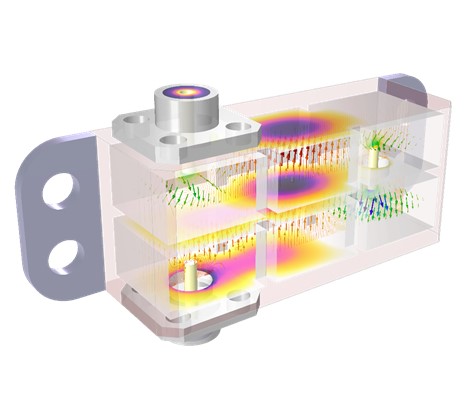COMSOL offered a preview of the upcoming release of COMSOL Multiphysics® version 5.6 at the COMSOL Conference 2020 North America, October 7–8. It is planned to be released in fall 2020 and brings faster and more memory-efficient solvers, better CAD assembly handling, application layout templates and a range of new graphics features including clip planes, realistic material rendering, and partial transparency.
For RF engineers, the RF Module and Wave Optics Module provide a new option for port sweeps, enabling faster computations of full S-parameters or transmission and reflection coefficient matrices. This functionality can be applied to the analysis of passive 5G components such as microwave filters with a large number of ports. A new modeling tool for approximate asymptotic scattering allows for quick far-field and radar cross section (RCS) analysis for convex-shaped objects. A new set of postprocessing tools makes it easier to visualize and analyze polarization, with important applications for a variety of periodic structures including metamaterials for optics and microwaves. The new version of the Ray Optics Module includes faster ray tracing and specialized tools for scattering from surfaces and within volumetric domains.
A summary of the highlights includes:
- Frequency Domain Source Sweep
- Fast port sweep for full S-parameter matrix
- Reuse LU decomposition
- Electromagnetic Waves, Asymptotic Scattering
- Very like physical optics without iteration
- Quick far field and RCS analysis for a convex shaped
- object
- Port enhancement
- Numeric TEM without magnetic field integration line
- TEM port for 2D and 2D axisymmetric
- Lumped port power excitation
- Touchstone file export in postprocessing
 New model examples provided included:
New model examples provided included:
- Thermo structural effects on a 5G mmWave cavity filter
- Fast asymptotic analysis of a conductive sphere
- Modeling of a phased array antenna
- Basic emission and immunity test of a circuit board
Complete Highlights in Version 5.6:
• General updates
o Clip plane, box, sphere and cylinder for easier selection inside complex CAD models
o Solution time decreased by 30 percent or more for many types of simulations
o Improved cluster performance and scalability
o New IPOPT optimization solver
o Templates for standardized application layouts for desktops, tablets and smartphones
o Control knob form objects
o Realistic material rendering of plastics, metals and organic materials
o Partial transparency in visualizations
• New Products
o Fuel Cell and Electrolyzer Module for accurate simulation of hydrogen fuel cells and water electrolyzers
o Polymer Flow Module for analyzing non-Newtonian fluids
o LiveLink™ for Simulink® for cosimulation of COMSOL Multiphysics® and Simulink®
o Liquid and Gas Properties Module for realistic fluid and fluid mixture properties
• Electromagnetics
o Parasitic inductance computations with L-matrix extraction
o Material models for laminated iron cores used in motors and transformers
o Ferroelectric material model for electrostatics
o 322 magnetic materials from Bomatec®
o Coupled RF, thermal, and stress analysis tutorial for 5G applications
o Faster ray tracing, scattering in domains and from surfaces for ray optics
• Structural Mechanics
o Mechanical contact: transient contact and wear modeling
o Crack modeling with J-integral and stress intensity factor computations and phase-field-based damage simulation
o Poroelasticity in composite shells
o Embedded reinforcements for anchors, rebars and wire meshes
o Automatic generation of joints for multibody dynamics
o Rigid body contact
o Active magnetic bearings for rotordynamics
o Ferroelectric elasticity including nonlinear piezoelectricity with hysteresis and polarization saturation
• Acoustics
o Nonlinear acoustics for high-intensity ultrasound
o Sound distortion in mobile device loudspeakers due to nonlinear thermoviscous effects
o Mechanical port conditions for analyzing vibration paths and mechanical feedback
o New boundary element method formulation for large scattering volumes including sonar applications
o Room acoustics metrics including reverberation time, definition and clarity using ray acoustics
o Faster impulse response for ray acoustics
o Waveform Audio File export
• Fluid and Heat
o Shallow water equations interface
o Faster and more memory-efficient CFD solving
o Droplet evaporation for particle tracing
o Directional surface properties for heat radiation
o Phase change interfaces
• Chemical and Electrochemical
o Material library for corrosion
o Realistic fluid models for dry air, moist air and steam
o Automatic reaction balancing
o Reactive pellet beds for concentrated solutions
• CAD Import Module, Design Module and LiveLink™ products for CAD
o Easier detection of gaps and overlaps in assemblies
o More robust solid operations for imported CAD models and CAD assemblies
o Measuring dimensions and automatic parameter creation for the constraints and dimensions functionality
o Faster and more robust ECAD import


Recent Comments
Is there a reason the OMICRON Lab Bode...
Some of these are obsolete so will be...
Don't forget MegiQ: https://www.saelig.com/category/megiq-vector-network-analyzers.htm...
Hello Admin, Excellent stuff! Your level of quality work...
An interesting article but a bad use of...